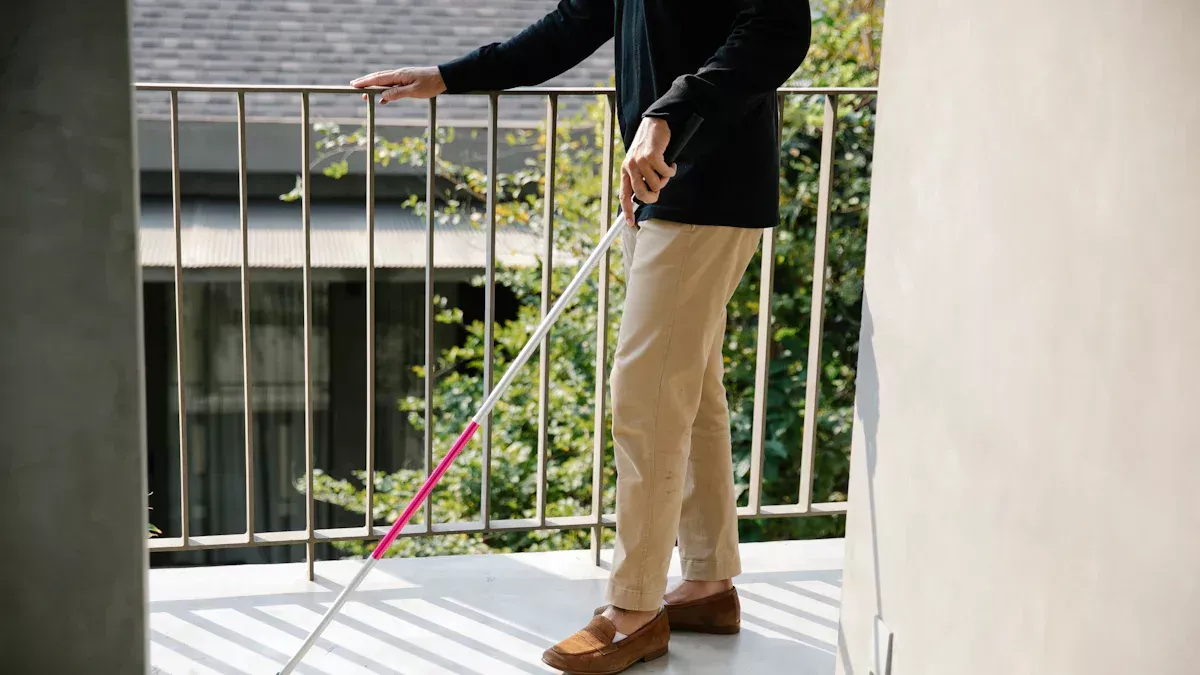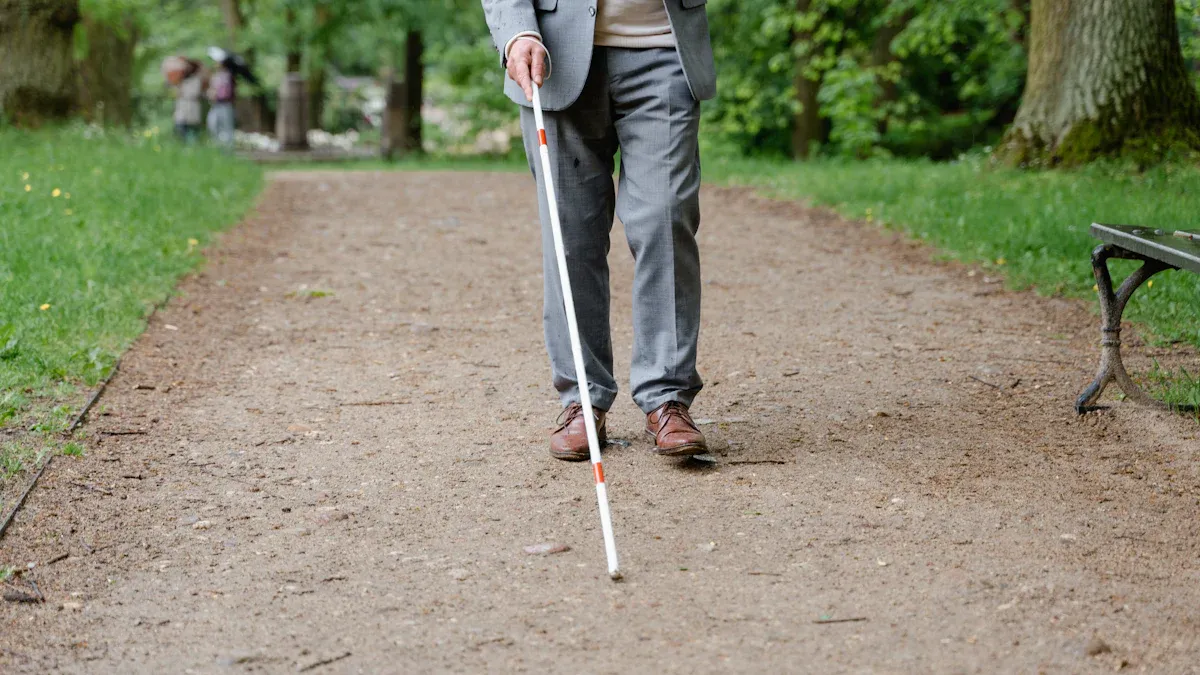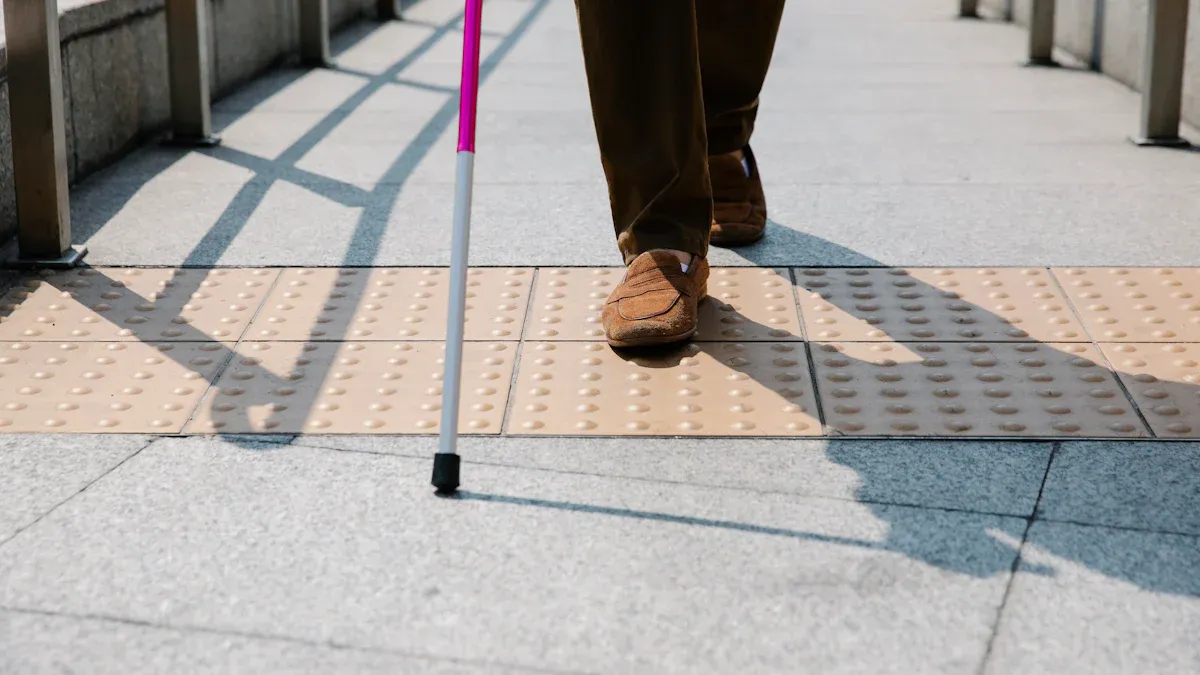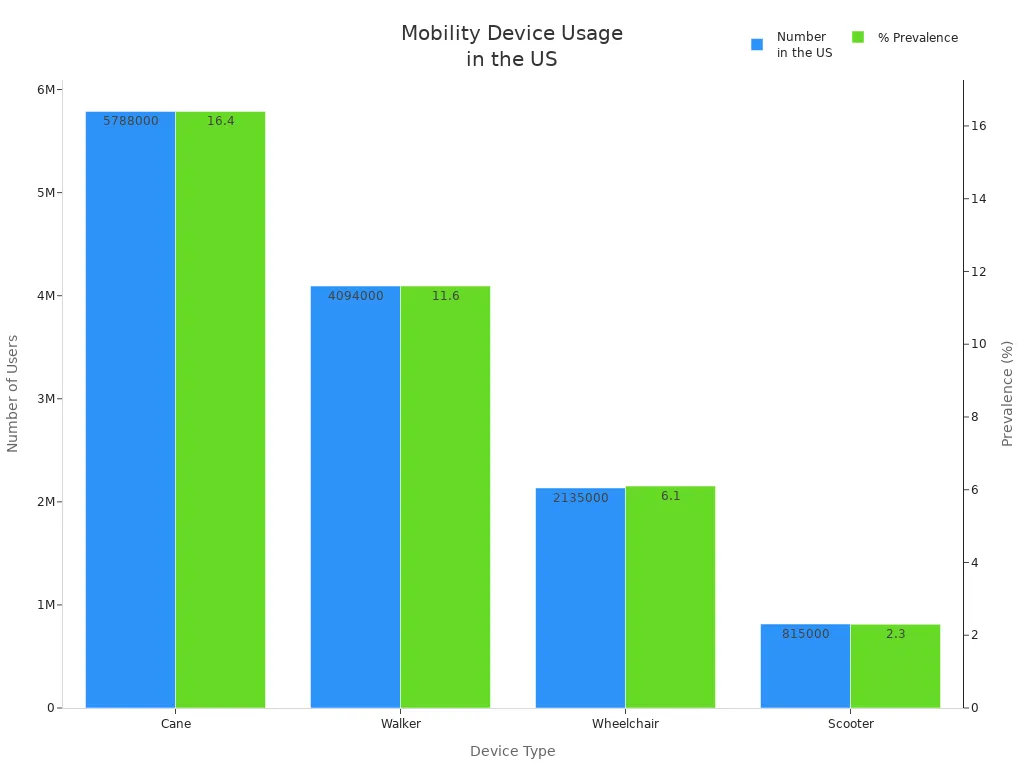Views: 0 Author: Site Editor Publish Time: 2025-09-16 Origin: Site









Choosing between a walking stick and a walking cane depends on what you need most. If you want light support, better posture, or something that looks stylish, a walking stick might fit you best. Many people like that it helps with arm strength and doesn't stress the shoulders. For daily help or medical reasons, a cane gives more support. Think about your comfort, where you'll walk, and how much help you want.
Walking sticks help with balance and are great for outdoor use. Canes give strong support for daily walking and medical help. Think about where you walk most. Walking sticks work well on rough ground. Canes are better for flat, indoor floors. Comfort is very important. Pick a walking aid with a handle that feels nice in your hand. This helps stop your hand from getting tired. Talk to a healthcare professional to check what you need. They can help you pick the right mobility aid for your life. Try both walking sticks and canes before you choose. This helps you find what feels best and keeps you steady.
Let's look at how walking sticks and walking canes are different. Seeing them side by side can help you pick the right one.
Feature | Walking Stick | Walking Cane |
|---|---|---|
Purpose | Balance, posture, outdoor activities | Medical support, daily mobility |
Support | Light, helps with stability | Strong, helps bear weight |
Terrain | Uneven ground, hiking trails | Indoors, smooth surfaces |
Daily Use | Occasional, recreational | Frequent, everyday |
Materials | Bamboo, composite, leather | Composite, plastic, ergonomic handles |
Innovations | LED lights, GPS, shock absorption | Fall sensors, emergency alerts |
Walking sticks are good for balance and outdoor fun. Canes give more help if you need support every day or for health reasons.
Here is a short list to help you choose:
Support Level: Walking sticks help you stay balanced. Canes help you carry weight if you are hurt or weak.
Where You Use It: Walking sticks work well outside, even on rough ground. Canes are best inside or on smooth floors.
Comfort and Style: Walking sticks look cool and feel light. Canes are made for comfort, with special handles and rubber tips.
Materials: Bamboo and leather make walking sticks light and stylish. Canes use strong materials like composite and plastic.
Latest Features: Some walking aids have LED lights for night walks, GPS for safety, and sensors to warn caregivers. You can also find special handles and shock absorption for a smoother walk.
Tip: Think about what you need most. If you want more help, a cane may be better. If you just need balance, a walking stick could work. You can ask a healthcare expert for advice that fits you.

You might wonder when you should use a walking stick. If you want light support and better balance, a walking stick can help you feel steadier. Many people use a walking stick for extra stability when walking on uneven ground or just moving around outside. You do not need to rely on it all the time, but it gives you confidence when you need it.
A walking stick is lighter than a cane. You can carry it easily and use it only when you want. Some people like to use a walking stick for posture. It helps you stand tall and walk with more control. You may notice that your arm feels stronger after using a walking stick for a while.
Did you know? Trekking poles, which are a type of walking stick, help improve balance and stability during outdoor activities like hiking. They give you extra support and make you feel safer.
Studies show that walking sticks help you keep your balance. Here are some findings:
Trekking poles minimize postural sway on uneven surfaces, which helps prevent trips and falls.
Using a walking stick can improve gait stability and balance, especially when you walk downhill. It also reduces stress on your lower limb joints.
Research found that walking sticks can lower muscle and cartilage damage during downhill walking, especially for people who need extra support.
You will find a walking stick most useful outdoors. If you like hiking, walking on trails, or exploring parks, a walking stick gives you better stability. It helps you move over rocks, sand, and gravel without slipping. You can use a walking stick to test the ground ahead or to steady yourself on steep paths.
A walking stick is perfect for uneven terrain. You get extra points of contact with the ground, which means you are less likely to fall. People who use a walking stick often walk faster and feel more confident. You may notice that your posture improves and you feel safer on rough ground.
Walking sticks increase stability and reduce the risk of falls by giving you more traction on tricky surfaces.
Many people say that using a walking stick helped them avoid becoming frequent fallers. They walk with more speed and feel steadier.
Walking sticks are great for sand, gravel, and other challenging terrains. You get added grip and support.
If you want occasional support and enjoy outdoor activities, a walking stick is a smart choice. You do not have to use it all the time, but it is there when you need it. You can pick a walking stick that fits your style and feels comfortable in your hand.

You might need a cane if you need help walking. A cane gives extra support when your leg feels weak. It helps if you are healing from an injury. Many people use a cane after breaking a bone. You may need one for a bad sprain or strain. Some people use a cane for hip problems. Others use it after surgery on their knee or leg.
Here are some reasons you might need a cane:
Healing from broken bones in your leg or foot
Balancing with bad sprains or strains in your knee or ankle
Managing hip problems
Recovering from surgery on your knee or lower leg
Recovering from a stroke
Managing balance and strength problems as you get older
Managing a disability that is permanent or temporary
Managing some chronic conditions, like multiple sclerosis or Parkinson's disease
Managing a birth defect
A cane helps you move weight off your weak or hurt leg. You can walk with less pain and feel more sure of yourself. Doctors often tell people to use a cane if they need help moving every day.
Studies show using a cane helps you recover faster. For example, research found stroke patients who use a cane walk better. They also have stronger muscles. If you cannot put much weight on your leg, a cane gives you support. Experts say learning to use a cane helps your body heal faster.
Here is a table showing what researchers found about cane use:
Study | Findings |
|---|---|
Choi et al. | More muscle activity in the leg helps stroke patients walk better and need the cane less. |
Guillebastre et al. | If you can only put a little weight on your weak leg, you will probably need a cane to walk. |
Bastian | Learning new ways to move is important for recovery. |
Tip: If you feel shaky or your doctor says you need help, a cane can help you walk safely and heal faster.
A cane is not just for injuries. You may need a cane for medical reasons. Some people use a cane every day because of health problems or disabilities. You might see someone using a cane if they have trouble walking because of age, a stroke, or a disease like Parkinson's.
Look at how many people in the US use a cane or other device:
Device | Number in the US | % Prevalence (95% CI) |
|---|---|---|
Cane | 5,788,000 | 16.4 (15.5–17.3) |
Walker | 4,094,000 | 11.6 (10.8–12.5) |
Wheelchair | 2,135,000 | 6.1 (5.5–6.7) |
Scooter | 815,000 | 2.3 (1.9–2.8) |
Any device use (≥1) | 8,506,000 | 24.1(23–25.2) |

A cane can help you with many health problems. You might use a cane if you have:
Balance and strength problems as you get older
A disability that is permanent or temporary
Chronic conditions like multiple sclerosis or Parkinson's disease
A birth defect that makes walking hard
When you use a cane, you want it to feel safe and easy. Many canes have handles that fit your hand well. This design makes it easier to hold and less tiring. You will feel less pain in your hand and wrist. Rubber tips on the cane help you grip the ground. They also help you walk on smooth or slippery floors.
Here are some features that make a cane safer and easier:
Handles that fit your hand help you feel comfortable.
Rubber tips help you stay steady and not slip.
Note: Handles and rubber tips make your cane safer and more comfortable. You can walk longer and feel more sure of yourself.
A walking cane is a good choice if you need help every day. You can find many styles and features to fit your needs. Whether you need support for an injury, a health problem, or just want to feel steadier, a cane can help you move with confidence.
When you choose a mobility aid, you need to think about how much help you want. Your body weight and strength matter. If you need a little support, a walking stick might be enough. If you need to put more weight on the aid, a cane is better. You should check the weight capacity for each type. This keeps you safe and steady. Your physical condition is important. Ask yourself how far you can walk without pain. If you get tired quickly, you may need a mobility aid with extra features. Some people need a seat to rest. Others just want something to lean on. You should also think about your grip strength and coordination. If you have trouble holding things, look for a handle that feels good in your hand.
Tip: Talk to your doctor or therapist before you pick a mobility aid. They can help you find the best option for your needs.
Comfort makes a big difference when you use a mobility aid every day. The handle should fit your hand and feel soft. Foam grips and ergonomic handles help prevent hand fatigue. You can choose a style that matches your personality. Some people like classic wooden canes. Others prefer modern designs with bright colors. You can pick a handle shape that feels right for you. Here's a quick look at handle designs:
Handle Design | Comfort Level | Style Appeal |
|---|---|---|
Derby | High | Classic |
Fritz | High | Classic |
Knob | Moderate | Historical |
Ergonomic | Very High | Modern |
You can find mobility aids made from wood, metal, or acrylic. Each material has its own look and feel. Choose one that makes you happy and comfortable.
Where you use your mobility aid matters. If you walk outside on rough ground, a walking stick works well. If you move around indoors or on smooth floors, a cane is a good choice. Think about your day-to-day activities. Do you need help at home, in the park, or while shopping? Your environment will guide your decision. Some mobility aids have special tips for extra grip. Others have features for safety, like lights or alarms. Make sure your aid matches your lifestyle and the places you go.
Weight capacity
Comfort
Adjustability
Safety features
Mobility needs
You should always consider your surroundings before you choose. The right mobility aid will help you stay active and confident.
You want to pick the right walking aid, so start by thinking about your own needs. Ask yourself if you need help for a short time or every day. Look at where you walk most—do you spend time outside on rough ground, or do you move around indoors? Think about any other mobility issues you have. Here's a simple checklist to help you:
Decide if you need support for a short time or long-term.
Think about the terrain you walk on most.
Check if you have other mobility challenges.
Make sure the cane or stick fits your height and feels comfortable.
When you choose a cane or walking stick, focus on what helps you move safely. Picking the right aid means you avoid injuring themselves and stay active.
Trying different options can make a big difference. You might find that one feels better than the other. Some people like the balance of a walking stick, while others need the strong support of a cane. You can test different heights and handle shapes. Here's a table to show why trying both matters:
Benefit | Why It Helps |
|---|---|
Individual Comfort | You find what feels best for your body. |
Height Adjustment | You get the right fit for easy walking. |
Professional Guidance | Experts can watch you walk and give advice. |
You should try walking with each device before you decide. This helps you find the best fit for your stability and comfort.
Talking to a healthcare professional is always a smart move. Physical therapists and doctors know how to match you with the right walking aid. They can check your strength and balance. They also teach you how to use your cane or stick the right way, so you avoid falls and injuries. Professionals make sure your choice matches your needs.
If you want a walking aid that meets strict safety standards, look for trusted brands. Quzhi Medical follows 32 quality inspection steps and meets international certifications like ISO 13485 and CE. Their products are reliable and safe for everyday use.
Tip: Don't choose just by looks. Make sure your walking aid works for you and keeps you safe.
You've seen how walking sticks and canes serve different needs.
Canes give you long-term support and help you bear weight.
Walking sticks work best for occasional use and style.
Think about your comfort, your walking environment, and how much help you want. Both options can boost your confidence and help you move better. Here's what experts suggest:
What to Do | Why It Matters |
|---|---|
Evaluate your needs | Find the right level of support |
Consult a professional | Get advice that fits you |
Choose trusted brands | Enjoy safety and quality |
You deserve a walking aid that matches your life and keeps you moving forward.
You use a walking stick for balance and style. You pick a cane when you need strong support for walking or medical reasons. Each helps you move, but they work best in different situations.
You get extra stability with a walking stick, especially on rough ground. It helps you stay steady and lowers your risk of falling over when you walk outside or hike.
You should try different handles to see what feels good in your hand. Some people like soft foam grips. Others prefer classic wood. Comfort matters most for daily use.
You get the best advice from your doctor or physical therapist. They know your health needs and can help you pick the right walking aid for your body and lifestyle.
